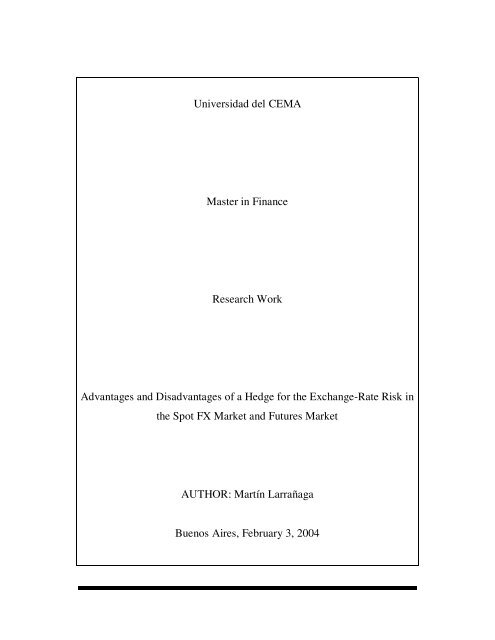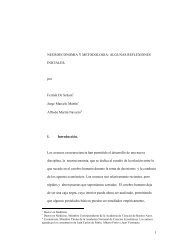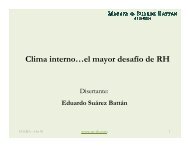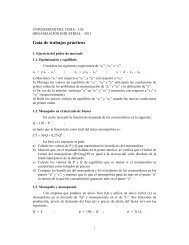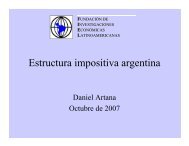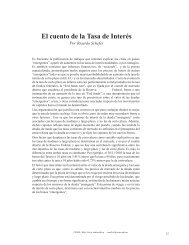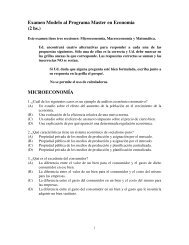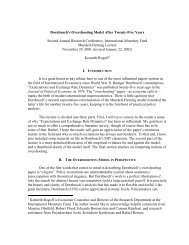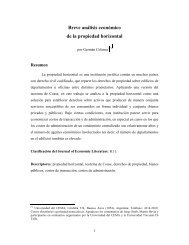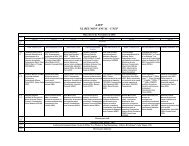Universidad del CEMA Master in Finance Research Work ...
Universidad del CEMA Master in Finance Research Work ...
Universidad del CEMA Master in Finance Research Work ...
Create successful ePaper yourself
Turn your PDF publications into a flip-book with our unique Google optimized e-Paper software.
<strong>Universidad</strong> <strong>del</strong> <strong>CEMA</strong><br />
<strong>Master</strong> <strong>in</strong> F<strong>in</strong>ance<br />
<strong>Research</strong> <strong>Work</strong><br />
Advantages and Disadvantages of a Hedge for the Exchange-Rate Risk <strong>in</strong><br />
the Spot FX Market and Futures Market<br />
AUTHOR: Martín Larrañaga<br />
Buenos Aires, February 3, 2004
Abstract<br />
It is the purpose of this research work to compare the advantages and disadvantages of<br />
us<strong>in</strong>g the Spot Forex and Futures markets to hedge the exchange-rate risk, thus<br />
provid<strong>in</strong>g with the necessary tools to chose either for one or other market based on the<br />
characteristics of each hedg<strong>in</strong>g.<br />
On the other hand, this work has the purpose of expla<strong>in</strong><strong>in</strong>g the way the spot Forex<br />
market works, which is not often expla<strong>in</strong>ed on the books, especially to hedge the<br />
exchange-rate risk. In general, academic books which discuss hedg<strong>in</strong>g for the<br />
exchange-rate risk limit themselves to deal with the Futures market, Forwards<br />
Contracts and Options.
The Evolution of FX Markets ................................................................................. 3<br />
The Explosion of the Euromarket........................................................................... 4<br />
What is Foreign Exchange ...................................................................................... 4<br />
Who are the players <strong>in</strong> the Forex market? ............................................................. 5<br />
Spot Forex Market vs. Equity Market..................................................................... 5<br />
24-Hour Trad<strong>in</strong>g ................................................................................................ 5<br />
Liquidity ............................................................................................................. 6<br />
Profit Potential <strong>in</strong> both Ris<strong>in</strong>g and Fall<strong>in</strong>g Markets............................................. 6<br />
Spot Forex Market vs. Futures Market................................................................... 6<br />
Leverage ........................................................................................................... 6<br />
Volume of Futures Contracts ............................................................................. 8<br />
Transaction Costs.............................................................................................. 8<br />
Expiration of Futures Contracts. ........................................................................ 9<br />
Policy on Marg<strong>in</strong> Accounts. ............................................................................... 9<br />
Example of a Hedge for the Exchange Rate Risk ................................................. 11<br />
Data on prices of the EURUSD currency pair. ..................................................... 11<br />
Spot and Futures Prices of the EURUSD currency pair ................................... 11<br />
Hedge for the Exchange-rate Risk us<strong>in</strong>g the Spot FX Market .............................. 13<br />
Calculation of the number of contracts to be purchased .................................. 13<br />
Calculation of Funds for the marg<strong>in</strong> account.................................................... 13<br />
Analysis of Losses and/or Ga<strong>in</strong>s...................................................................... 14<br />
Outcome of Hedge at the obligation’s maturity date......................................... 16<br />
Hedge for the Exchange-rate Risk us<strong>in</strong>g the Futures Market............................... 17<br />
Calculation of the number of contracts to be purchased. ................................. 17<br />
Calculation of the Optimal Hedge Ratio (h)...................................................... 17<br />
Calculation of Funds for the Marg<strong>in</strong> Account. .................................................. 18<br />
Analysis of Losses and/or Ga<strong>in</strong>s...................................................................... 18<br />
Outcome of the Hedge at the obligation’s maturity date................................... 19<br />
Analysis of Basis Risk............................................................................................ 20<br />
Def<strong>in</strong>ition of Basis Risk........................................................................................ 20<br />
Basis risk due to the obligation’s maturity date.................................................... 21<br />
Basis risk due to the number of traded contracts................................................. 22<br />
Conclusions............................................................................................................ 23<br />
Advantages of the Spot FX market over the Futures market................................ 23<br />
Leverage. ........................................................................................................ 23<br />
Hedg<strong>in</strong>g dur<strong>in</strong>g the life of the hedge................................................................ 23<br />
Basis Risk........................................................................................................ 24<br />
Transaction Costs............................................................................................ 24<br />
Advantages of the Futures Market over the Spot Forex Market. .......................... 24<br />
Hedg<strong>in</strong>g of <strong>in</strong>terest-rate risk............................................................................. 24<br />
Organized Market vs. Over-the-counter Market (OTC) .................................... 25<br />
F<strong>in</strong>al Conclusion.................................................................................................. 25<br />
Comments .............................................................................................................. 26<br />
2
The Evolution of FX Markets<br />
The Gold Exchange and the Bretton Woods Agreement<br />
In 1967, a Chicago bank refused a college professor by the name of Milton Friedman<br />
a loan <strong>in</strong> pound sterl<strong>in</strong>g because he had <strong>in</strong>tended to use the funds to short the British<br />
currency. Friedman, who had perceived sterl<strong>in</strong>g to be priced too high aga<strong>in</strong>st the<br />
dollar, wanted to sell the currency, then later buy it back to repay the bank after the<br />
currency decl<strong>in</strong>ed, thus pocket<strong>in</strong>g a quick profit. The bank’s refusal to grant the loan<br />
was due to the Bretton Woods Agreement, established twenty years earlier, which<br />
fixed national currencies aga<strong>in</strong>st the dollar, and set the dollar at a rate of $35 per<br />
ounce of gold.<br />
The Bretton Woods Agreement, set up <strong>in</strong> 1944, aimed at <strong>in</strong>stall<strong>in</strong>g <strong>in</strong>ternational<br />
monetary stability by prevent<strong>in</strong>g money from flee<strong>in</strong>g across nations, and restrict<strong>in</strong>g<br />
speculation <strong>in</strong> the world currencies. Prior to the Agreement, the gold exchange<br />
standard--prevail<strong>in</strong>g between 1876 and World War I--dom<strong>in</strong>ated the <strong>in</strong>ternational<br />
economic system. Under the gold exchange, currencies ga<strong>in</strong>ed a new phase of<br />
stability as they were backed by the price of gold. It abolished the age-old practice<br />
used by k<strong>in</strong>gs and rulers of arbitrarily debas<strong>in</strong>g money and trigger<strong>in</strong>g <strong>in</strong>flation.<br />
But the gold exchange standard didn’t lack faults. As an economy strengthened, it<br />
would import heavily from abroad until it ran down its gold reserves required to back<br />
its money; consequently, the money supply would shr<strong>in</strong>k, <strong>in</strong>terest rates rose and<br />
economic activity slowed to the extent of recession. Ultimately, prices of goods had<br />
hit bottom, appear<strong>in</strong>g attractive to other nations, who would rush <strong>in</strong>to buy<strong>in</strong>g sprees<br />
that <strong>in</strong>jected the economy with gold until it <strong>in</strong>creased its money supply, and drive<br />
down <strong>in</strong>terest rates and recreate wealth <strong>in</strong>to the economy. Such boom-bust patterns<br />
prevailed throughout the gold standard until the outbreak of World War I <strong>in</strong>terrupted<br />
trade flows and the free movement of gold.<br />
After the Wars, the Bretton Woods Agreement was founded, where participat<strong>in</strong>g<br />
countries agreed to try and ma<strong>in</strong>ta<strong>in</strong> the value of their currency with a narrow marg<strong>in</strong><br />
aga<strong>in</strong>st the dollar and a correspond<strong>in</strong>g rate of gold as needed. Countries were<br />
prohibited from devalu<strong>in</strong>g their currencies to their trade advantage and were only<br />
allowed to do so for devaluations of less than 10%. Into the 1950s, the ever-expand<strong>in</strong>g<br />
volume of <strong>in</strong>ternational trade led to massive movements of capital generated by postwar<br />
construction. That destabilized foreign exchange rates as setup <strong>in</strong> Bretton Woods.<br />
3
The Agreement was f<strong>in</strong>ally abandoned <strong>in</strong> 1971, and the US dollar would no longer be<br />
convertible <strong>in</strong>to gold. By 1973, currencies of major <strong>in</strong>dustrialized nations floated<br />
more freely, as they were controlled ma<strong>in</strong>ly by the forces of supply and demand.<br />
Prices were floated daily, with volumes, speed and price volatility all <strong>in</strong>creas<strong>in</strong>g<br />
throughout the 1970s, giv<strong>in</strong>g rise to new f<strong>in</strong>ancial <strong>in</strong>struments, market deregulation<br />
and trade liberalization.<br />
In the 1980s, cross-border capital movements accelerated with the advent of<br />
computers and technology, extend<strong>in</strong>g market cont<strong>in</strong>uum through Asian, European and<br />
American time zones. Transactions <strong>in</strong> foreign exchange rocketed from about $70<br />
billion a day <strong>in</strong> the 1980s, to more than $1.5 trillion a day two decades later.<br />
The Explosion of the Euromarket<br />
A major catalyst to the acceleration of Forex trad<strong>in</strong>g was the rapid development of the<br />
eurodollar market; where US dollars are deposited <strong>in</strong> banks outside the US. Similarly,<br />
Euromarkets are those where assets are deposited outside the currency of orig<strong>in</strong>. The<br />
Eurodollar market first came <strong>in</strong>to be<strong>in</strong>g <strong>in</strong> the 1950s when Russia’s oil revenue-- all<br />
<strong>in</strong> dollars -- was deposited outside the US <strong>in</strong> fear of be<strong>in</strong>g frozen by US regulators.<br />
That gave rise to a vast offshore pool of dollars outside the control of US authorities.<br />
The US government imposed laws to restrict dollar lend<strong>in</strong>g to foreigners.<br />
Euromarkets were particularly attractive because they had far less regulations and<br />
offered higher yields. From the late 1980s onwards, US companies began to borrow<br />
offshore, f<strong>in</strong>d<strong>in</strong>g Euromarkets a beneficial center for hold<strong>in</strong>g excess liquidity,<br />
provid<strong>in</strong>g short-term loans and f<strong>in</strong>anc<strong>in</strong>g imports and exports.<br />
London was, and rema<strong>in</strong>s the pr<strong>in</strong>cipal offshore market. In the 1980s, it became the<br />
key center <strong>in</strong> the Eurodollar market when British banks began lend<strong>in</strong>g dollars as an<br />
alternative to pounds <strong>in</strong> order to ma<strong>in</strong>ta<strong>in</strong> their lead<strong>in</strong>g position <strong>in</strong> global f<strong>in</strong>ance.<br />
London’s convenient geographical location (operat<strong>in</strong>g dur<strong>in</strong>g Asian and American<br />
markets) is also <strong>in</strong>strumental <strong>in</strong> preserv<strong>in</strong>g its dom<strong>in</strong>ance <strong>in</strong> the Euromarket.<br />
What is Foreign Exchange<br />
Foreign Exchange (FOREX) is the arena where a nation's currency is exchanged for<br />
that of another. The foreign exchange market is the largest f<strong>in</strong>ancial market <strong>in</strong> the<br />
world, with the equivalent of over $1.5 trillion chang<strong>in</strong>g hands daily; more than three<br />
times the aggregate amount of the US Equity and Treasury markets comb<strong>in</strong>ed. Unlike<br />
4
other f<strong>in</strong>ancial markets, the Forex market has no physical location and no central<br />
exchange. It operates through a global network of banks, corporations and <strong>in</strong>dividuals<br />
trad<strong>in</strong>g one currency for another. The lack of a physical exchange enables the Forex<br />
market to operate on a 24-hour basis, spann<strong>in</strong>g from one zone to another <strong>in</strong> all the<br />
major f<strong>in</strong>ancial centers.<br />
Traditionally, retail <strong>in</strong>vestors’ only means of ga<strong>in</strong><strong>in</strong>g access to the foreign exchange<br />
market was through banks that transacted large amounts of currencies for commercial<br />
and <strong>in</strong>vestment purposes. Trad<strong>in</strong>g volume has <strong>in</strong>creased rapidly over time, especially<br />
after exchange rates were allowed to float freely <strong>in</strong> 1971. Comb<strong>in</strong>ation of low marg<strong>in</strong><br />
and high leverage has changed the way the Interbank currency market operates. In this<br />
way, Forex has been opened to retail <strong>in</strong>vestors, giv<strong>in</strong>g them the professional tools and<br />
services needed to trade effectively <strong>in</strong> an <strong>in</strong>dependent atmosphere.<br />
Who are the players <strong>in</strong> the Forex market?<br />
The Forex market has been called Interbank market for a long time due to the fact it<br />
was traded by banks, <strong>in</strong>clud<strong>in</strong>g central banks, commercial banks and <strong>in</strong>vestment<br />
banks. As we have mentioned before, trad<strong>in</strong>g volume <strong>in</strong> this market has rapidly<br />
<strong>in</strong>creased, due to, among other factors, the market players have <strong>in</strong>creased throughout<br />
the time. Today, we can mention <strong>in</strong>ternational large corporations, global money<br />
managers, <strong>in</strong>ternational brokers, options and futures traders and speculators as players<br />
of this market.<br />
Spot Forex Market vs. Equity Market<br />
24-Hour Trad<strong>in</strong>g<br />
Forex is a true 24-hour market. It opens every Sunday at 17:00hs (New York time)<br />
when the Eastern hemisphere’s stock exchanges open and closes every Friday at<br />
15:00hs (New York time) when the US stock exchanges are closed down. This trad<strong>in</strong>g<br />
operation time offers a major advantage over equities trad<strong>in</strong>g. Therefore, traders can<br />
always respond to break<strong>in</strong>g news immediately around the world, which have an effect<br />
on this market. Furthermore, unlike the prices at the equities market, the spot FX<br />
market does not have gaps between the clos<strong>in</strong>g and open<strong>in</strong>g prices of a day dur<strong>in</strong>g the<br />
trad<strong>in</strong>g week; we can only f<strong>in</strong>d gaps between the clos<strong>in</strong>g and open<strong>in</strong>g prices of a new<br />
week.<br />
5
Liquidity<br />
The daily trad<strong>in</strong>g volume <strong>in</strong> the spot FX market is approximately 50x larger than that<br />
of the New York Stock Exchange; there are always brokers or dealers will<strong>in</strong>g to buy<br />
or sell currencies <strong>in</strong> the FX markets. Traders <strong>in</strong> this market can always open or close<br />
positions at the market price, that is, there is always a counterparty will<strong>in</strong>g to make an<br />
opposite transaction, thanks to this market liquidity.<br />
Because of the lower trade volume, <strong>in</strong>vestors <strong>in</strong> the stock market are more vulnerable<br />
to liquidity risk, which results <strong>in</strong> a wider deal<strong>in</strong>g spread or larger price movements <strong>in</strong><br />
response to any relatively large transaction.<br />
Profit Potential <strong>in</strong> both Ris<strong>in</strong>g and Fall<strong>in</strong>g Markets<br />
When a trader opens a position <strong>in</strong> the FX market, what he is really do<strong>in</strong>g is to go long<br />
<strong>in</strong> a currency and short <strong>in</strong> another one. For example: <strong>in</strong> the case a trader opens a long<br />
position <strong>in</strong> the EURUSD currency pair, what he is <strong>in</strong> fact do<strong>in</strong>g is to be long <strong>in</strong> Euros<br />
and short <strong>in</strong> US dollars, or otherwise, he is buy<strong>in</strong>g Euros and sell<strong>in</strong>g US dollars.<br />
When the reverse transaction is made <strong>in</strong> this market, that is, to be short <strong>in</strong> the<br />
EURUSD currency pair means exactly the same with regard to the required marg<strong>in</strong>s<br />
and type of transaction. Both trad<strong>in</strong>g operations, long and short positions <strong>in</strong> any<br />
currency pair are opened us<strong>in</strong>g marg<strong>in</strong> accounts; this means that both trade operations<br />
are leveraged. While <strong>in</strong>vest<strong>in</strong>g <strong>in</strong> equities is rather differently, s<strong>in</strong>ce the short position<br />
is the only one who needs leverage and this is not always available.<br />
Spot Forex Market vs. Futures Market<br />
Leverage<br />
Understand<strong>in</strong>g leverage procedures at the spot Forex market is a key element of this<br />
research work.<br />
The most important difference between the spot FX market and futures market lies <strong>in</strong><br />
the leverage used. Consequences that this difference have on the analysis of a hedge<br />
for the exchange-rate risk are the ma<strong>in</strong> focus and approach of this research work.<br />
All currency pairs are quoted aga<strong>in</strong>st the US dollar as per the follow<strong>in</strong>g convention:<br />
Euro<br />
British Pound<br />
EURUSD<br />
GBPUSD<br />
6
Yen<br />
Swiss Franc<br />
Canadian Dollar<br />
USDJPY<br />
USDCHF<br />
USDCAD<br />
Contracts traded <strong>in</strong> the Forex market are of 100,000 units of the first currency pair’s<br />
acronym. For example, when we are trad<strong>in</strong>g EURUSD, either buy<strong>in</strong>g or sell<strong>in</strong>g, we<br />
are do<strong>in</strong>g each transaction for an amount equal to EUR 100,000, but when we are<br />
trad<strong>in</strong>g the Canadian Dollar we are do<strong>in</strong>g this transaction for USD 100,000.<br />
M<strong>in</strong>imum marg<strong>in</strong> per contract <strong>in</strong> the FX market goes separately from the currency<br />
traded and it is an amount of USD 500 per each contract. This means that leverage<br />
will depend on the currency to be traded.<br />
As an example, we will calculate leverage for the EURUSD currency pair. Let’s<br />
suppose that the spot exchange-rate for the EURUSD currency pair is 1.2000. As we<br />
have expla<strong>in</strong>ed above, <strong>in</strong> the case of transactions <strong>in</strong> the EURUSD currency pair,<br />
trades are made for the amounts of EUR100,000. Therefore, with 1 contract of USD<br />
500, the <strong>in</strong>vestor is trad<strong>in</strong>g for the amount of EUR 100,000, which, at the spot Forex<br />
exchange rate, represents a transaction of EUR 100,000 * 1.2000 = USD 120,000.<br />
Then, leverage at the beg<strong>in</strong>n<strong>in</strong>g of the transaction is 240:1; this means that the<br />
<strong>in</strong>vestor, with USD 500 has traded for an equivalent amount of USD 120,000.<br />
In the Futures market, leverage on the Euro futures contract is as follows:<br />
Data from the CME (Chicago Mercantile Exchange) Market as of December 15,<br />
2003.<br />
US dollars (USD) Euros (EUR)<br />
Initial Marg<strong>in</strong> USD 2,498<br />
Ma<strong>in</strong>tenance Marg<strong>in</strong> USD 1,850<br />
Trad<strong>in</strong>g Vol. / Contract EUR 125,000<br />
Therefore, we will have two k<strong>in</strong>ds of leverage; one at the beg<strong>in</strong>n<strong>in</strong>g of the transaction<br />
or <strong>in</strong>itial and the other one will be the ma<strong>in</strong>tenance leverage.<br />
Leverages were calculated us<strong>in</strong>g the data provided by the CME as of December 15,<br />
2003 shown <strong>in</strong> the previous table.<br />
In order to calculate the <strong>in</strong>itial leverage, we will consider the <strong>in</strong>itial marg<strong>in</strong> account,<br />
thus:<br />
7
L i = Initial leverage.<br />
L i = Volume per futures contract multiplied by the exchange rate’s spot price divided<br />
by the <strong>in</strong>itial marg<strong>in</strong> EUR 125,000 * 1.2000 / USD 2,498 = 60<br />
L i = 60:1<br />
In order to calculate the ma<strong>in</strong>tenance leverage, we will use the ma<strong>in</strong>tenance marg<strong>in</strong><br />
account, thus:<br />
L m = ma<strong>in</strong>tenance leverage.<br />
L m = Volume per futures contract multiplied by the exchange rate’s spot price divided<br />
by the ma<strong>in</strong>tenance marg<strong>in</strong> account EUR 125,000 * 1.2000 / USD 1,850 = 81<br />
L m = 81:1<br />
To sum up, leverage <strong>in</strong> the futures market as well as <strong>in</strong> the Forex market shall depend<br />
on the exchange rate’s spot price. In the particular case of a spot price equal to 1.200,<br />
leverages for the futures market are L i = 60:1 and L m = 81:1 respectively, while<br />
leverage <strong>in</strong> the Forex market is 240:1<br />
Consequences of such difference will be analyzed <strong>in</strong> the conclusions section of this<br />
research work.<br />
Volume of Futures Contracts<br />
As we have expla<strong>in</strong>ed above, m<strong>in</strong>imum traded contract <strong>in</strong> the futures market is EUR<br />
125,000; this means that if an <strong>in</strong>vestor wishes to hedge an EUR 400,000 position,<br />
he/she has to buy a number of contracts equivalent to EUR 400,000 / EUR 125,000 =<br />
3.2 contracts. Consequently, said <strong>in</strong>vestor shall have to choose whether to buy 3 or 4<br />
futures contracts with the associated risks that this implies. Meanwhile, m<strong>in</strong>imum<br />
trade contracts <strong>in</strong> the FX market are, <strong>in</strong> the case of the Euro, of EUR 100,000, thus<br />
exist<strong>in</strong>g the possibility to buy portions of one contract be<strong>in</strong>g multiple of EUR 10,000.<br />
That is, if an <strong>in</strong>vestor wishes to go either long or short of Euros for an amount of EUR<br />
150,000, then he/she has to buy 1.5 contracts. S<strong>in</strong>ce the Forex market is more flexible<br />
with regard to the m<strong>in</strong>imum contract volume, this implies that the risks to exactly<br />
hedge the position required are lower than those at the futures market.<br />
Transaction Costs<br />
It is hereby understood that transaction costs are the costs charged by brokers to buy<br />
or sell currencies <strong>in</strong> the market. Thus, Forex market has a competitive advantage over<br />
the equities and derivatives markets, s<strong>in</strong>ce the only transaction cost charged is the<br />
spread.<br />
8
Spread <strong>in</strong> the spot FX market shall exclusively depend on the broker. As an example,<br />
deal<strong>in</strong>g spreads offered by brokers of this market are normally 5 pips (1 pip is 0.0001<br />
cents of US dollar) for the strongest currencies. If we consider for example the Euro-<br />
US dollar currency pair, bid /ask prices, can respectively be as follows: EURUSD Bid<br />
1.2250, Ask 1.2255. In general, the deal<strong>in</strong>g spread is lower than the average deal<strong>in</strong>g<br />
spread offered <strong>in</strong> the equities and futures markets, and this is due to this market’s<br />
liquidity.<br />
Both <strong>in</strong> the futures market and equities market, <strong>in</strong> addition to the deal<strong>in</strong>g spread,<br />
brokers also charge a transaction cost for the purchase and sale of each contract that<br />
has been entered <strong>in</strong>to. We here<strong>in</strong> mention the average transaction costs charged by<br />
brokers <strong>in</strong> the futures market: USD 7.75 per each contract and transaction, whether it<br />
is a purchase or a sale, plus Clear<strong>in</strong>g and Exchange fees and those charged by the<br />
National Futures Association (NFA), which are USD 0.02 and USD 0.05 per each<br />
transaction and contract, respectively.<br />
Expiration of Futures Contracts.<br />
Expiration of contracts <strong>in</strong> the currency futures market is quarterly <strong>in</strong> the follow<strong>in</strong>g<br />
months: March, June, September and December, and physical <strong>del</strong>ivery takes place on<br />
the third Wednesday of each of the above-mentioned months.<br />
On the contrary, <strong>in</strong> the spot FX market, currencies are purchased or sold at the spot<br />
price of that moment. In this way, if an <strong>in</strong>vestor wishes to hedge a currency position<br />
as of February 28, today he/she opens a position <strong>in</strong> the spot FX market and closes it<br />
up at its expiration date, meanwhile <strong>in</strong> the futures market such <strong>in</strong>vestor shall have to<br />
choose to enter <strong>in</strong>to a futures contract with a pre-established expiration date, which<br />
maybe either March or December to hedge the position on February. This implies a<br />
basis risk due to the difference <strong>in</strong> the expiration dates between the futures contract’s<br />
expiration and that one of the <strong>in</strong>vestor’s obligation.<br />
Policy on Marg<strong>in</strong> Accounts.<br />
There are two types of marg<strong>in</strong> accounts <strong>in</strong> the currency futures market, the <strong>in</strong>itial<br />
marg<strong>in</strong> account and the ma<strong>in</strong>tenance marg<strong>in</strong> account, while <strong>in</strong> the spot Forex market<br />
there is only the ma<strong>in</strong>tenance marg<strong>in</strong> account.<br />
Unlike the futures contract, which the <strong>in</strong>vestor arranges a future price, either to<br />
purchase or to sell a currency, <strong>in</strong> the spot FX market the current currency price is<br />
be<strong>in</strong>g traded.<br />
9
Therefore, a very important difference exist<strong>in</strong>g between these two markets lies <strong>in</strong> the<br />
fact that <strong>in</strong> the spot FX market, overnight <strong>in</strong>terests are charged or paid for open<br />
positions at the clos<strong>in</strong>g of each trad<strong>in</strong>g day. Said overnight <strong>in</strong>terests are related to the<br />
short-term <strong>in</strong>terest rates of the countries <strong>in</strong>volved <strong>in</strong> the currency pairs that are be<strong>in</strong>g<br />
traded. It is worth not<strong>in</strong>g that such <strong>in</strong>terests are calculated over the traded volume and<br />
not over the amount of the marg<strong>in</strong> account.<br />
Example for the EURUSD currency pair:<br />
An <strong>in</strong>vestor wants to buy EURUSD at the spot exchange rate of 1.2000, therefore<br />
what he is do<strong>in</strong>g is buy<strong>in</strong>g EUR 100,000 and sell<strong>in</strong>g USD 120,000. Consequently,<br />
he/she will be paid with the European daily <strong>in</strong>terest rates for the traded amount of<br />
EUR 100,000 and shall pay the American daily <strong>in</strong>terest rate on account of USD<br />
120,000.<br />
S<strong>in</strong>ce Europe’s short-term <strong>in</strong>terest-rates are at present higher than those of the USA,<br />
such <strong>in</strong>terest-rate spread on account of the traded volume will be deposited daily <strong>in</strong><br />
this <strong>in</strong>vestor’s marg<strong>in</strong> account.<br />
It is important to note that this calculation is made each day, that is, if dur<strong>in</strong>g an open<br />
position the short-term <strong>in</strong>terest-rates curves are <strong>in</strong>verted, i.e., USA’s <strong>in</strong>terest-rates go<br />
higher than Europe’s, the <strong>in</strong>vestor shall have to pay daily overnight <strong>in</strong>terests rates.<br />
The overnight <strong>in</strong>terest-rate calculation will depend, as we have expla<strong>in</strong>ed before, on<br />
the effective short-term <strong>in</strong>terest rates, and moreover, each broker offers bid/ask<br />
<strong>in</strong>terest rates for each currency pairs. As an example of the above, the follow<strong>in</strong>g table<br />
shows the daily overnight <strong>in</strong>terest rates <strong>in</strong> US dollars offered by a Forex broker as at<br />
December 22, 2003 per each open position of 100,000 units:<br />
Currency Long Short<br />
EURUSD $ 2.50 $ -7.50<br />
USDJPY $ 3.00 $ -8.00<br />
GBPUSD $ 9.00 $ -14.00<br />
USDCHF $ - $ -5.00<br />
AUDUSD $ 6.50 $ -11.50<br />
USDCAD $ 2.00 $ -7.00<br />
In the case the <strong>in</strong>vestor opens a long position on the EURUSD currency pair of a unit,<br />
i.e. EUR 100,000, he/she shall daily receive USD 2.5 <strong>in</strong> his/her marg<strong>in</strong> account. On<br />
the other hand, <strong>in</strong> the case the position is short on the EURUSD currency pair, the<br />
broker will withdraw USD 7.5 each day from such <strong>in</strong>vestor’s marg<strong>in</strong> account.<br />
10
In summary, the broker will pay <strong>in</strong>terest rates to the <strong>in</strong>vestor over the traded volume if<br />
the <strong>in</strong>vestor is buy<strong>in</strong>g the currency of the country with higher short-term <strong>in</strong>terest rates<br />
than the currency he/she is sell<strong>in</strong>g.<br />
This difference exist<strong>in</strong>g on the payment of the overnight <strong>in</strong>terest rates <strong>in</strong> the futures<br />
market will be discussed <strong>in</strong> the conclusions section of this research work.<br />
Example of a Hedge for the Exchange Rate Risk<br />
S<strong>in</strong>ce operations at the currency spot FX markets and futures contract have been<br />
understood together with its differences and similarities, we will now discuss an<br />
example a hedg<strong>in</strong>g for the exchange–rate risk.<br />
Let’s suppose that today is January 2 nd , 2003 and the USA-based company XXX has<br />
an obligation for the amount of EUR 10,400,000 with a European creditor, to be paid<br />
off on October 20, 2003. This company wants to hedge the exchange-rate risk, both<br />
ris<strong>in</strong>g and fall<strong>in</strong>g exchange rate fluctuations; therefore, the company would like to<br />
hedge the amount <strong>in</strong> US dollars that it shall have to pay off at the obligation’s<br />
maturity date.<br />
In order to purchase said hedge, the company decides to compare the advantages and<br />
disadvantages of hedg<strong>in</strong>g this risk through the currencies futures market versus the<br />
leveraged spot Forex market.<br />
Data on prices of the EURUSD currency pair.<br />
The analysis on the hedges will be made ex-post, therefore, the data which has been<br />
used are actual data provided by the Bloomberg source.<br />
Spot and Futures Prices of the EURUSD currency pair<br />
Chart 1 shows the fluctuation <strong>in</strong> the futures contracts’ prices of the EURUSD<br />
currency pair to expire at December 2003 and the spot price between January 2, 2003<br />
and October 20, 2003.<br />
11
EURUSD Price<br />
1.18<br />
1.16<br />
1.14<br />
1.12<br />
1.1<br />
1.08<br />
1.06<br />
1.04<br />
EURUSD Spot Exchange Rate<br />
EURUSD Futures Exchange Rate<br />
1.02<br />
1/2/03 2/1/03 3/3/03 4/2/03 5/2/03 6/1/03 7/1/03 7/31/03 8/30/03 9/29/03<br />
DATE<br />
Chart 1: Bloomberg Source<br />
The data on the spot FX market corresponds to the clos<strong>in</strong>g of each day and this<br />
happens every day at 15:00hs NY. This co<strong>in</strong>cides with the open<strong>in</strong>g of the next day’s<br />
trad<strong>in</strong>g session, s<strong>in</strong>ce, as we have mentioned before, the currency spot FX market<br />
rema<strong>in</strong>s open 24 hours a day. The reason why the spot FX market makes a rollover of<br />
positions at 15:00hs NY time is to calculate the open positions’ overnight <strong>in</strong>terest<br />
rates. In the case of the futures contract, the data provided is that one of that trad<strong>in</strong>g<br />
session’s clos<strong>in</strong>g price.<br />
In chart 2, it is shown a Bloomberg screen where the characteristics of the Euro<br />
futures contract used for hedg<strong>in</strong>g are shown. This data was obta<strong>in</strong>ed on November 4,<br />
2003.<br />
12
Chart 2: Bloomberg Source.<br />
Hedge for the Exchange-rate Risk us<strong>in</strong>g the Spot FX Market<br />
Calculation of the number of contracts to be purchased<br />
The amount to be hedged is EUR 10,400,000, therefore it shall be necessary to buy an<br />
X number of contracts, which shall be closer to the Euros value of the hedge. As we<br />
have expla<strong>in</strong>ed before, <strong>in</strong> the particular case of the EURUSD currency pair, each<br />
contract is entered <strong>in</strong>to for the amount of EUR 100,000, thus the number of contracts<br />
will be as follows: EUR 10,400,000 / EUR 100,000 = 104 contracts. In this particular<br />
case, through the purchase of 104 contracts at the spot FX market, the company will<br />
purchase exactly the value <strong>in</strong> Euros of its future obligation.<br />
Calculation of Funds for the marg<strong>in</strong> account<br />
Based on the number of contracts necessary for the hedg<strong>in</strong>g, which number is already<br />
known (104 contracts), the m<strong>in</strong>imum number necessary to fund the marg<strong>in</strong> account<br />
shall be:<br />
USD 500 ¡ 1 Contract<br />
USD X<br />
¡ 104 Contracts<br />
Then X = 104 contracts * USD 500 / 1 contract = USD 52,000<br />
13
This means that the XXX company with an amount of USD 52,000 may purchase <strong>in</strong><br />
the spot Forex market at the currency exchange rate of 1.0359 on January 2, 2003 an<br />
equivalent amount to EUR 10,400,000.<br />
S<strong>in</strong>ce the company is buy<strong>in</strong>g Euros and sell<strong>in</strong>g US Dollars, if the currency exchange<br />
rate goes down, i.e. the US Dollar is be<strong>in</strong>g appreciated, the broker will require a<br />
marg<strong>in</strong> call from the company. Then, it is at the company’s discretion to fund the<br />
marg<strong>in</strong> account with an amount higher than the ma<strong>in</strong>tenance marg<strong>in</strong> of USD 52,000<br />
<strong>in</strong> order to avoid quick and successive marg<strong>in</strong> calls.<br />
It is also at the company’s discretion to withdraw funds from the marg<strong>in</strong> account <strong>in</strong><br />
the case the Euro is appreciated, that is to say, if the currency exchange rate goes up.<br />
A very much-used criterion to manage the marg<strong>in</strong> account is VaR (Value at Risk),<br />
which gives us the daily maximum loss based on the underly<strong>in</strong>g assets’ volatility.<br />
Consequently, us<strong>in</strong>g said calculation, the company may decide to ma<strong>in</strong>ta<strong>in</strong> for<br />
example the marg<strong>in</strong> account with the m<strong>in</strong>imum ma<strong>in</strong>tenance marg<strong>in</strong> of USD 52,000<br />
plus the daily maximum loss calculated with the VaR method, and multiplied by x<br />
number of days necessary to give the company time to make the necessary money<br />
transfers to the broker and, therefore, to avoid to be required a marg<strong>in</strong> call until the<br />
last day of the hedge.<br />
Analysis of Losses and/or Ga<strong>in</strong>s.<br />
Based on the above-mentioned data necessary to purchase a hedge, the purpose is to<br />
show how Losses/Ga<strong>in</strong>s of the marg<strong>in</strong> account have developed <strong>in</strong> this market.<br />
In chart 1, the exchange rate’s daily evolution of the EURUSD currency pair was<br />
shown s<strong>in</strong>ce January to October 2003. In view of this evolution, the XXX company’s<br />
marg<strong>in</strong> account <strong>in</strong> the broker will be chang<strong>in</strong>g. Losses or ga<strong>in</strong>s can be seen <strong>in</strong> chart 3<br />
based on the spot exchange rate for the period covered by the hedge.<br />
14
Analysis of losses and ga<strong>in</strong>s dur<strong>in</strong>g the life of Hedge<br />
$ 2,000,000<br />
$ 1,500,000<br />
G/L of the FX position<br />
Company's unhedged position<br />
Net Position<br />
$ 1,000,000<br />
$ 500,000<br />
$ 0<br />
2-Jan-03 2-Feb-03 5-Mar-03 5-Apr-03 6-May-03 6-Jun-03 7-Jul-03 7-Aug-03 7-Sep-03 8-Oct-03<br />
$ -500,000<br />
$ -1,000,000<br />
$ -1,500,000<br />
$ -2,000,000<br />
Chart 3:<br />
It is important to note that the (y) axis amounts are expressed <strong>in</strong> US dollars. The blue<br />
l<strong>in</strong>e shows the Loss/Ga<strong>in</strong> of the open position at the spot Forex market, without tak<strong>in</strong>g<br />
the overnight <strong>in</strong>terest rates <strong>in</strong>to account, meanwhile the red l<strong>in</strong>e shows the company<br />
exposure throughout the obligation term <strong>in</strong> the case it had decided not to be hedged.<br />
In other words, it is the company’s unhedged position based on the spot exchange<br />
rate. As it was expected, the yellow l<strong>in</strong>e <strong>in</strong> the chart shows that the company’s net loss<br />
or ga<strong>in</strong> as the result of hedg<strong>in</strong>g its exposure to the exchange rate risk dur<strong>in</strong>g the hedge<br />
period is be<strong>in</strong>g null; this is without consider<strong>in</strong>g the overnight <strong>in</strong>terest rates.<br />
In fact, this is not completely true, s<strong>in</strong>ce we have to take <strong>in</strong>to account the overnight<br />
<strong>in</strong>terest rates charged or paid by the broker to the <strong>in</strong>vestor, as we have expla<strong>in</strong>ed <strong>in</strong><br />
the leverage section. In this case, the Euro zone’s short-term <strong>in</strong>terest rates were higher<br />
than those of the USA dur<strong>in</strong>g the hedge period; therefore the company will receive<br />
overnight <strong>in</strong>terest rates every day.<br />
15
¢<br />
Outcome of Hedge at the obligation’s maturity date<br />
At the hedge expiration on October 20, the Euro spot price was 1.1646, therefore, the<br />
XXX company closes its position at the spot FX market and it may buy, for example,<br />
the Euros necessary to pay off its obligation at an exchange house.<br />
The follow<strong>in</strong>g table shows the data at the beg<strong>in</strong>n<strong>in</strong>g and the end of the hedge.<br />
Date<br />
Spot Exchange<br />
Rate<br />
(EURUSD)<br />
Debt <strong>in</strong> EUR Debt <strong>in</strong> USD<br />
Loss/Ga<strong>in</strong> <strong>in</strong><br />
FX Position<br />
Overnight<br />
Interest<br />
rates<br />
Net<br />
Position<br />
2-Jan-03 1.0359 * ** $ - $ - $ -<br />
20-Oct-03 1.164610,400,000 $ 12,111,840 $ 1,338,480 $ 75,920 $ 1,414,400<br />
On January 2, the obligation assumed by the company of EUR 10,400,000, at the spot<br />
FX exchange rate of 1.0359, represented the amount <strong>in</strong> US dollars of EUR 10,400,000<br />
x 1.0359 = USD 10,773,360.<br />
On October 20, the company shall pay the obligation for the amount of EUR<br />
10,400,000. To such purpose, the company closes out its position <strong>in</strong> the spot market,<br />
thus receiv<strong>in</strong>g the net position of USD 1,414,400. S<strong>in</strong>ce its obligation <strong>in</strong> US dollars as<br />
at October 20, is of EUR 10,400,000 x 1.1646 = USD 12,111,840, the company shall<br />
add to the Forex position an amount of US dollars equal to USD 12,111,840 – USD<br />
1,414,400 = USD 10,697,440 to purchase EUR 10,400,000, and <strong>in</strong> this way to pay off<br />
its obligation.<br />
As we can see, this amount does not match with the USD 10,773,360, which<br />
represented the liability as at January 2, 2003 <strong>in</strong> USD 75,920, that corresponded to the<br />
<strong>in</strong>terests received by the company. Thus, we can conclude that <strong>in</strong> this particular case,<br />
the company was benefited when it received such <strong>in</strong>terests.<br />
(*) (**) S<strong>in</strong>ce we do not exactly know the borrow<strong>in</strong>g rates the company may obta<strong>in</strong> <strong>in</strong><br />
USA or <strong>in</strong> Europe, we are not able to accurately calculate the company’s liability of<br />
EUR 10,400,000, which represented <strong>in</strong> Euros as well as <strong>in</strong> US dollars as at October<br />
20, 2003.<br />
16
Hedge for the Exchange-rate Risk us<strong>in</strong>g the Futures Market<br />
Calculation of the number of contracts to be purchased.<br />
As we have mentioned before, the Euro m<strong>in</strong>imum futures contracts are of EUR<br />
125,000, the amount to be hedged is EUR 10,400,000; therefore the number of<br />
contracts required is EUR 10,400,000 / EUR 125,000 = 83.2 contracts.<br />
Calculation of the Optimal Hedge Ratio (h)<br />
The “h” hedge ratio shows us the optimal number of futures contracts necessary to<br />
hedge the exposure <strong>in</strong> a dynamic hedge. Def<strong>in</strong>e:<br />
∆S: change <strong>in</strong> spot price, S, dur<strong>in</strong>g a period of time equal to the life of the hedge.<br />
∆F: change <strong>in</strong> futures price, F, dur<strong>in</strong>g a period of time equal to the life of the hedge.<br />
σ S : standard deviation of ∆S.<br />
σ f : standard deviation of ∆F.<br />
ρ: coefficient of correlation between ∆S and ∆F.<br />
h: hedge ratio.<br />
The change <strong>in</strong> the value of the hedger’s position dur<strong>in</strong>g the life of the hedge is:<br />
h ∆F - ∆S, for a long hedge.<br />
∆S – h ∆F, when the hedger is long the asset and short the futures.<br />
In either case the variance, v, of the change <strong>in</strong> value of the hedged position is given<br />
by:<br />
v = σ s 2 + h 2 σ f 2 – 2hρσ s σ f<br />
so that<br />
∆v/∆h = 2h σ f 2 - 2ρσ s σ f = 0<br />
Sett<strong>in</strong>g this equal to zero, and not<strong>in</strong>g that ∆v 2 /∆h 2 is positive, we see that the value of<br />
h that m<strong>in</strong>imizes the variance is<br />
h = ρ (σ s / σ f )<br />
Coefficients so obta<strong>in</strong>ed as per the data of the example resulted <strong>in</strong>:<br />
σ s = 0.0400<br />
σ f = 0.0423<br />
ρ= 0.9980<br />
h = 0.9439<br />
Now we have to multiply the number of contracts obta<strong>in</strong>ed at the beg<strong>in</strong>n<strong>in</strong>g by the<br />
“h” optimal hedge ratio:<br />
17
83.2 contracts * 0.9439 = 78.53 contracts.<br />
The (h) ratio is used <strong>in</strong> the case of dynamic hedg<strong>in</strong>g, that is by calculat<strong>in</strong>g this ratio<br />
throughout the hedge period, we can decide whether to buy or sell contracts.<br />
We will not use a dynamic hedge for the example analyzed <strong>in</strong> this research work,<br />
therefore, the company has to decide whether to buy between 83 and 84 contracts. In<br />
this research work, we will make the calculations with 83 contracts and then, we will<br />
analyze the consequences of not purchas<strong>in</strong>g the exact number of contracts necessary<br />
to hedge such exact number.<br />
It is important to note that the fact of decid<strong>in</strong>g not to use a dynamic hedg<strong>in</strong>g and<br />
buy<strong>in</strong>g 83 futures contracts implies to purchase a hedge <strong>in</strong> Euros of: 83 Contracts *<br />
EUR 125,000 = EUR 10,375,000. Therefore, we have an exposure of EUR<br />
10,400,000 – EUR 10,375,000 = EUR 25,000. The effects of this exposure <strong>in</strong> Euros,<br />
which is unnecessary to the company, will be discussed <strong>in</strong> the analysis of basis risk.<br />
Calculation of Funds for the Marg<strong>in</strong> Account.<br />
Based on the number contracts necessary (83 contracts) to hedge the company’s<br />
exposure, and on the m<strong>in</strong>imum ma<strong>in</strong>tenance and <strong>in</strong>itial marg<strong>in</strong>s of: USD 1,850 and<br />
USD 2,498 respectively per each contract, the company will have to fund the <strong>in</strong>itial<br />
marg<strong>in</strong> account with a m<strong>in</strong>imum amount of:<br />
USD 2,498 * 83 contracts = USD 207,334<br />
And the company will also need to have a m<strong>in</strong>imum amount dur<strong>in</strong>g the hedge <strong>in</strong><br />
agreement with the ma<strong>in</strong>tenance marg<strong>in</strong> of:<br />
USD 1,850 * 83 contracts = USD 153,550<br />
As <strong>in</strong> the case of the hedge us<strong>in</strong>g the spot FX market, we leave at the company’s<br />
discretion the management of the marg<strong>in</strong> account, that is, to have certa<strong>in</strong> amounts of<br />
funds <strong>in</strong> such account <strong>in</strong> excess of the ma<strong>in</strong>tenance marg<strong>in</strong> <strong>in</strong> order to avoid marg<strong>in</strong><br />
calls.<br />
Analysis of Losses and/or Ga<strong>in</strong>s.<br />
The evolution of the futures price of the Euro as at December 2003 was shown <strong>in</strong><br />
chart 1 dur<strong>in</strong>g the hedge period. In view of this evolution, the company’s marg<strong>in</strong><br />
account <strong>in</strong> the broker will be chang<strong>in</strong>g dur<strong>in</strong>g the life of the hedge.<br />
Chart 4 shows the losses or ga<strong>in</strong>s both of the open position <strong>in</strong> the futures market as<br />
well as the loss or ga<strong>in</strong> that the company would have had <strong>in</strong> the case that it has<br />
decided not to hedge its exposure dur<strong>in</strong>g its period.<br />
18
Analysis of losses and ga<strong>in</strong>s dur<strong>in</strong>g the Life of the Hedge<br />
$ 2,000,000<br />
$ 1,500,000<br />
$ 1,000,000<br />
$ 500,000<br />
$ 0<br />
2-Jan-03 2-Feb-03 5-Mar-03 5-Apr-03 6-May-03 6-Jun-03 7-Jul-03 7-Aug-03 7-Sep-03 8-Oct-03<br />
$ -500,000<br />
$ -1,000,000<br />
$ -1,500,000<br />
G/L of the futures position<br />
Company's unhedged position<br />
Net Position<br />
$ -2,000,000<br />
Chart 4<br />
It is important to note that the (y) axis amounts are expressed <strong>in</strong> US dollars. The blue<br />
l<strong>in</strong>e shows the Loss/Ga<strong>in</strong> of the open position at the futures market, meanwhile the<br />
red l<strong>in</strong>e shows the company exposure throughout the obligation term <strong>in</strong> the case that it<br />
had decided not to be hedged. In other words, it is the company’s unhedged position<br />
based on the spot exchange-rate. The yellow l<strong>in</strong>e <strong>in</strong> the chart shows that the<br />
company’s net loss or ga<strong>in</strong> dur<strong>in</strong>g the hedge period, unlike the spot FX market, is<br />
chang<strong>in</strong>g throughout the time, and this is due to the fact that the Euro futures contract<br />
price is different to the change shown by the spot exchange rate.<br />
Outcome of the Hedge at the obligation’s maturity date.<br />
At the expiration of the hedge on October 20, the XXX company closes out its<br />
position at the futures market and buys the Euros necessary to pay off its obligation at<br />
an exchange house.<br />
The follow<strong>in</strong>g table shows the data at the beg<strong>in</strong>n<strong>in</strong>g and the end of the hedge.<br />
19
Date<br />
Spot Futures Debt amount<br />
Exchange rate Exchange Rate <strong>in</strong> EUR<br />
(EURUSD) (EURUSD)<br />
Debt amount<br />
<strong>in</strong> USD<br />
Loss/Ga<strong>in</strong><br />
Futures Position<br />
2-Jan-03 1.0359 $ 1.0250* ** $ -<br />
20-Oct-03 1.1646 $ 1.1640 £¥¤§¦©¨¦¦¨ ¦¦¦ $ 12,111,840 $ 1,442,125.00<br />
On October 20, the company shall pay off the obligation for the amount of EUR<br />
10,400,000. To such purpose, the company closes out its position <strong>in</strong> the futures<br />
market, thus receiv<strong>in</strong>g USD 1,442,125. S<strong>in</strong>ce its obligation <strong>in</strong> US dollars as at<br />
October 20, is of USD 12,111,840, the company shall add to the futures position an<br />
amount of US dollars equal to USD 12,111,840 – USD 1,442,125 = USD 10,669,715<br />
to purchase EUR 10,400,000, and <strong>in</strong> this way to pay off its obligation.<br />
(*) (**) Like <strong>in</strong> the case of the spot FX market hedge, s<strong>in</strong>ce we do not exactly know<br />
the borrow<strong>in</strong>g rates the company may obta<strong>in</strong> <strong>in</strong> USA or <strong>in</strong> Europe, we are not able to<br />
accurately calculate which amount the company’s obligation of EUR 10,400,000 as of<br />
January 2 represents <strong>in</strong> Euros and <strong>in</strong> US dollars as at October 20, 2003.<br />
Analysis of Basis Risk<br />
There are a number of reasons why hedg<strong>in</strong>g us<strong>in</strong>g futures contracts works less than<br />
perfectly <strong>in</strong> practice:<br />
1. The asset to be hedged may not be exactly the same as the asset underly<strong>in</strong>g<br />
the futures contract.<br />
2. The futures contract’s expiration date may be different to the hedge’s<br />
expiration date.<br />
3. The hedge amount may not co<strong>in</strong>cide with the exact number of futures<br />
contracts.<br />
In our case, we will only discuss the basis risks described <strong>in</strong> item 2 and 3 because the<br />
basis risk of item 1 is not applicable s<strong>in</strong>ce there are currency futures contracts to<br />
hedge the exchange-rate (the Euro).<br />
Def<strong>in</strong>ition of Basis Risk<br />
The basis risk <strong>in</strong> a futures contract hedg<strong>in</strong>g is def<strong>in</strong>ed as follows:<br />
Basis = spot price of asset to be hedged – futures price of contract used<br />
If the asset to be hedged and the asset underly<strong>in</strong>g the futures contract are the same,<br />
the basis should be zero at the expiration of the futures contract.<br />
20
However, dur<strong>in</strong>g the hedge period, that is prior to expiration of the futures contract,<br />
the basis may be positive or negative.<br />
The follow<strong>in</strong>g charts show that at the expiration of the futures contract, the price of<br />
the futures contract is the same than the spot price. However, dur<strong>in</strong>g the futures<br />
period, the basis risks are not necessarily zero.<br />
Futures price<br />
Spot price<br />
Spot price<br />
Futures price<br />
Time<br />
Time<br />
This also can be shown <strong>in</strong> chart 1, where we can see that when the expiration of the<br />
futures contract is closer (Dec 2003), the futures price is closer to the currency spot<br />
price.<br />
We can see that when the spot price <strong>in</strong>creases by more than the futures price, the<br />
basis risk <strong>in</strong>creases. This is referred to as a strengthen<strong>in</strong>g of the basis. When the<br />
futures price <strong>in</strong>creases by more than the spot price, the basis risk decl<strong>in</strong>es. This is<br />
referred to as a weaken<strong>in</strong>g of the basis.<br />
To exam<strong>in</strong>e the basis risk of our example, we will use the follow<strong>in</strong>g notation:<br />
S 1 = EURUSD spot price as of January 2, 2003.<br />
S 2 = EURUSD spot price as of October 20, 2003.<br />
F 1 = Euro futures price as of January, 2 2003 with expiration date on Dec-2003.<br />
F 2 = Euro futures price as of October 20, 2003 with expiration date on Dec-2003.<br />
b 1 = basis as of January 2, 2003<br />
b 2 = basis as of October 20, 2003<br />
From the def<strong>in</strong>ition of basis risk:<br />
b 1 = S 1 - F 1.<br />
b 2 = S 2 – F 2.<br />
Basis risk due to the obligation’s maturity date.<br />
S<strong>in</strong>ce the maturity date of the company’s obligation is on October 20, and it does not<br />
match the futures contract expiration date of December 2003, then, there is a basis<br />
risk which we calculate as follows:<br />
S 1 = 1.0359<br />
21
S 2 = 1.1646<br />
F 1 = 1.0250<br />
F 2 = 1.1640<br />
In our example, we will calculate the basis risk with the data ex-post, while the hedge<br />
risk is actually associated with b 2 , which as of January 2, 2003 is unknown.<br />
b 1 = S 1 - F 1 = 1.0359 – 1.0250 = 0.0109<br />
b 2 = S 2 – F 2 = 1.1646 – 1.1640 = 0.0006<br />
The company is hedg<strong>in</strong>g the exchange-rate risk with a long position of futures<br />
contracts <strong>in</strong> Euros. Therefore, we can say that the effective price paid out by the<br />
company <strong>in</strong> the futures hedge is given by:<br />
S 2 + F 1 – F 2 = F 1 + b 2 = 1.0250 + 0.0006 = 1.0256<br />
We note that due to the fact that the company had to sell the futures contracts prior to<br />
expiration, <strong>in</strong> this particular case, the company had a loss s<strong>in</strong>ce it paid an additional<br />
amount of 0,0006 cents of US dollar per Euro.<br />
The yellow l<strong>in</strong>e <strong>in</strong> chart 5 shows this basis risk <strong>in</strong> US dollars dur<strong>in</strong>g the hedge period.<br />
Basis risk due to the number of traded contracts.<br />
A key factor affect<strong>in</strong>g the basis risk is the choice of the futures contract to be used for<br />
hedg<strong>in</strong>g. This choice has two elements:<br />
1. The choice of the asset underly<strong>in</strong>g the futures contract<br />
2. The choice of the futures contract ‘s expiration month<br />
When the maturity date of the company’s exposure does not exactly match the<br />
futures contract’s expiration date, a contract with a later expiration month is generally<br />
chosen <strong>in</strong> these circumstances. This is because futures prices are <strong>in</strong> some <strong>in</strong>stances<br />
quite erratic dur<strong>in</strong>g the expiration month. In general, basis risk <strong>in</strong>creases as the time<br />
difference between the hedge expiration and the futures contract’s expiration month<br />
<strong>in</strong>creases. However, <strong>in</strong> some situations the hedger may be <strong>in</strong>cl<strong>in</strong>ed to use shortmaturity<br />
futures contracts and roll them forward.<br />
In our example, the company hedged its EUR 10,400,000 exposure with 83 contracts<br />
of EUR 125,000. Therefore, it only hedged an amount <strong>in</strong> Euros of EUR 125,000 * 83<br />
contracts = EUR 10,375,000. The rema<strong>in</strong><strong>in</strong>g EUR 25,000 is then exposed to the<br />
exchange-rate risk.<br />
Without tak<strong>in</strong>g <strong>in</strong>terest rates <strong>in</strong>to account dur<strong>in</strong>g the hedge period and consider<strong>in</strong>g<br />
that the spot exchange rate as of January 2 was 1.0359 and as of October 20 was<br />
22
1.1646, the Euro was appreciated <strong>in</strong> (1.1646 – 1.0359)/1.0359 = 12.42%. The<br />
company was negatively affected by the unhedged EUR 25,000, due to the Euro<br />
appreciation.<br />
Conclusions<br />
After discuss<strong>in</strong>g an example of hedg<strong>in</strong>g for the exchange-rate risk <strong>in</strong> the spot FX<br />
market and futures market, and the associated basis risks, we will analyze the<br />
advantages and disadvantages of each market for this type of hedg<strong>in</strong>g.<br />
Advantages of the Spot FX market over the Futures market.<br />
Leverage.<br />
On page 7, leverage was analyzed <strong>in</strong> both markets and it was shown that the spot FX<br />
market has greater leverage; therefore we can conclude that the hedger needs less<br />
money to hedge its exposure us<strong>in</strong>g this market.<br />
In order to quantify this advantage with regard to the futures market, we will analyze<br />
leverages of ma<strong>in</strong>tenance marg<strong>in</strong> accounts of both markets and <strong>in</strong> this way place<br />
them under the same conditions. We are not tak<strong>in</strong>g <strong>in</strong>to account the <strong>in</strong>itial marg<strong>in</strong><br />
account of futures contracts.<br />
Follow<strong>in</strong>g with the example discussed <strong>in</strong> this research work, <strong>in</strong> order to hedge EUR<br />
10,400,000 <strong>in</strong> the futures market a m<strong>in</strong>imum ma<strong>in</strong>tenance marg<strong>in</strong> of USD 153,550<br />
was needed. And the whole amount of the obligation was not hedged thereby exist<strong>in</strong>g<br />
a rema<strong>in</strong><strong>in</strong>g unhedged EUR 25,000 due to the number of futures contracts traded.<br />
Meanwhile, a m<strong>in</strong>imum ma<strong>in</strong>tenance marg<strong>in</strong> of USD 52,000 was needed at the spot<br />
FX market to hedge the total amount of the obligation. That is to say, for the same<br />
hedg<strong>in</strong>g, due to a greater leverage needed at the spot FX market, it became that the<br />
futures market is more expensive by 295%.<br />
We can also achieve at the same result when compar<strong>in</strong>g the different leverages. As<br />
per the calculation obta<strong>in</strong>ed <strong>in</strong> the leverage analysis, the data of leverages for both<br />
markets are: 81:1 for the futures markets and 240:1 for the spot FX market.<br />
Hedg<strong>in</strong>g dur<strong>in</strong>g the life of the hedge<br />
As we have seen <strong>in</strong> chart 3, <strong>in</strong> the spot FX market, the hedger is hedged of the<br />
exchange-rate risk dur<strong>in</strong>g the period the position is open. While <strong>in</strong> the futures market,<br />
he only has 100% hedg<strong>in</strong>g at the expiration of the futures contract.<br />
23
This spot FX market’s advantage enables the hedger to cancel at any time his<br />
exposure to the exchange-rate risk and be 100% hedged.<br />
However, <strong>in</strong> the futures market there will be some times when the hedger will be<br />
over hedged and <strong>in</strong> other times he will be under hedged, as it is shown by the yellow<br />
l<strong>in</strong>e <strong>in</strong> chart 4.<br />
In the example discussed <strong>in</strong> this research work, the obligation’s maturity date was<br />
October 20, 2003, but if by any reason, the debtor or the creditor decides to advance<br />
or <strong>del</strong>ay said obligation’s maturity date, provided always the amount is the same, the<br />
hedger will be hedged, by clos<strong>in</strong>g out his position <strong>in</strong> the spot FX market, on the<br />
obligation’s new expiration date. In the futures market, on the contrary, <strong>in</strong> this case<br />
the hedger should roll the futures contract forward.<br />
Basis Risk.<br />
It was clearly stated <strong>in</strong> the basis risk analysis that the futures market is exposed to<br />
such risks, and depend<strong>in</strong>g on the hedge characteristics, that is, with regard to the<br />
obligation’s amount and maturity date, the basis risk may have a great <strong>in</strong>cidence on<br />
the outcome of the hedge. However, the spot Forex market is not exposed to this type<br />
of risks.<br />
Transaction Costs.<br />
In the section of the analysis of transaction costs, we could see that the spot Forex<br />
market has a competitive advantage over the futures market, s<strong>in</strong>ce the only<br />
transaction cost charged is the currencies spread.<br />
Therefore, likewise <strong>in</strong> the advantage of the basis risks above, and depend<strong>in</strong>g on the<br />
hedge characteristics with regard to the number of contracts and whether the latter is<br />
a dynamic hedge where futures contract are purchased and sold dur<strong>in</strong>g the hedge<br />
period, transaction costs may play a significant role <strong>in</strong> the election of the market to be<br />
used for the hedg<strong>in</strong>g.<br />
Advantages of the Futures Market over the Spot Forex Market.<br />
Hedg<strong>in</strong>g of <strong>in</strong>terest-rate risk.<br />
When the futures market is used to hedge a currency exposure, not only the exchange<br />
rate risk is be<strong>in</strong>g hedged but also the <strong>in</strong>terest-rate risk. That is to say, when a futures<br />
contract is entered <strong>in</strong>to, the currency price is be<strong>in</strong>g hedged regardless of how <strong>in</strong>terestrates<br />
of the countries <strong>in</strong>volved <strong>in</strong> the transaction fluctuate. Consequently, it may be<br />
24
calculated the amount <strong>in</strong> the local currency that will be needed to hedge the exposure<br />
<strong>in</strong> a foreign currency at the futures contract’s expiration date.<br />
If <strong>in</strong> the example discussed <strong>in</strong> this research work, the company obligation’s maturity<br />
date would have been on December 2003 likewise the futures contract’s expiration<br />
date, we could have said ex-ante that the company, at the expiration date, will need<br />
an amount <strong>in</strong> US dollars equal to: EUR 10,400,000 * 1.0250 = USD 10,660,000<br />
without regard to the <strong>in</strong>terest –rates fluctuation.<br />
On the other hand, <strong>in</strong> the spot Forex market, due to the overnight <strong>in</strong>terest rates which<br />
was expla<strong>in</strong>ed above <strong>in</strong> detail, the exchange-rate risk is the only risk be<strong>in</strong>g hedged,<br />
while the <strong>in</strong>terest-rate risk is not. This means that we could not precisely foresee <strong>in</strong><br />
advance at the obligation’ maturity date how much money will be necessary to hedge<br />
said obligation, s<strong>in</strong>ce this will depend on <strong>in</strong>terest-rates, be<strong>in</strong>g this a variable benefit<br />
or not for the hedg<strong>in</strong>g based on its characteristics.<br />
Therefore, we could <strong>in</strong>fer that, depend<strong>in</strong>g on the hedg<strong>in</strong>g characteristics, the futures<br />
market may be more beneficial for long-term exchange-rate risk hedges.<br />
Organized Market vs. Over-the-counter Market (OTC)<br />
The futures market is an organized market whereas the spot Forex market is an OTC<br />
market. Although quantify<strong>in</strong>g the risk <strong>in</strong> an OTC market is extremely difficult, we<br />
could <strong>in</strong>fer that the futures market is more secure than or that is less exposed to the<br />
market risk exposure. Therefore, choos<strong>in</strong>g a broker to trade <strong>in</strong> the spot Forex market<br />
plays an essential role <strong>in</strong> the decision to m<strong>in</strong>imize the risk <strong>in</strong>volved <strong>in</strong> an OTC<br />
market.<br />
Maybe many of the above-mentioned advantages of the spot Forex market vs. the<br />
futures market are expla<strong>in</strong>ed <strong>in</strong> terms of market risk.<br />
F<strong>in</strong>al Conclusion<br />
After discuss<strong>in</strong>g the characteristics of an exchange-rate risk hedge, and once we have<br />
analyzed the advantages and disadvantages of the spot Forex and futures markets, it<br />
is the purpose of this research work to provide with the necessary tools to chose what<br />
market is more suitable to be used for hedg<strong>in</strong>g this risk.<br />
As an example, we will mention a particular case where the spot Forex market is<br />
more convenient than the futures market.<br />
Let’s imag<strong>in</strong>e that a company has a short-term currency exposure and said exposure<br />
is chang<strong>in</strong>g <strong>in</strong> volume dynamically whether each day or per week. In this case, we<br />
25
can see that the spot Forex market is more suitable than the futures market due to the<br />
greater leverage, lower transaction costs and the advantage of avoid<strong>in</strong>g basis risks.<br />
The fact that the currency exposure changes dynamically makes the volume of the<br />
open position <strong>in</strong> the spot Forex market change along with the exposure fluctuations.<br />
Therefore, transaction costs associated with this type of hedg<strong>in</strong>g use to be very<br />
significant, thus the advantages of the spot Forex market are clearly evidenced.<br />
The spot FX market’s greater leverage vs. the futures market implies less money to<br />
hedge the company’s exposure.<br />
On the other hand, the fact of be<strong>in</strong>g a short-term hedge, the negative effect of the<br />
overnight <strong>in</strong>terest rates is attenuated by said short-term period of hedge; and this<br />
could favor the hedger <strong>in</strong> the event the spot Forex position receives such overnight<br />
<strong>in</strong>terest rates, if such is the case.<br />
Comments<br />
1. All registered US Futures Commission Merchants (FCM) and members of the<br />
National Futures Association (NFA) <strong>in</strong>volved <strong>in</strong> foreign exchange trad<strong>in</strong>g<br />
will beg<strong>in</strong> requir<strong>in</strong>g a m<strong>in</strong>imum marg<strong>in</strong> of 1% for all forex transactions as<br />
from December 1, 2003. This requirement will be implemented by all FCMs<br />
as a result of the National Futures Association’s new rule (BYLAW 306). For<br />
further details about this rule, please access the NFA’s website at the<br />
follow<strong>in</strong>g<br />
l<strong>in</strong>k<br />
http://www.nfa.futures.org/compliance/forexRuleAmendments.asp<br />
This new rule has an effect on the spot Forex market’s marg<strong>in</strong> account, s<strong>in</strong>ce<br />
as we have discussed <strong>in</strong> this research work, the spot market’s fixed m<strong>in</strong>imum<br />
marg<strong>in</strong> was USD 500 per each contract of 100,000 units. As from December<br />
1, 2003, all brokers registered <strong>in</strong> US will calculate the m<strong>in</strong>imum marg<strong>in</strong> as<br />
follows:<br />
1 contract of USD/JPY 1 contract of EUR/USD 1 contract of GBP/USD<br />
1% of USD 100,000 =<br />
USD 1,000<br />
1% of EUR 100,000 =<br />
EUR 1,000, which is<br />
USD 1,200*<br />
1% of GBP 100,000 =<br />
GBP 1,000, which is USD<br />
1,700**<br />
* Calculated at the spot rate of EURUSD = 1.2000<br />
** Calculated at the spot rate of GBPUSD = 1.7000<br />
26
It is important to note that although this rule is effective as from December 1,<br />
2003, it only comprises all entities registered <strong>in</strong> USA. Because of this reason,<br />
calculation of this work was not modified s<strong>in</strong>ce there are still numerous<br />
brokers around the world who are still requir<strong>in</strong>g a marg<strong>in</strong> of USD 500 per<br />
each contract of 100,000.<br />
It is worth not<strong>in</strong>g that due to this new rule be<strong>in</strong>g effective, <strong>in</strong> the case the<br />
<strong>in</strong>vestor decides to use a broker member of the NFA, he/she should deposit<br />
more funds <strong>in</strong> the marg<strong>in</strong> account of the spot market than the amount<br />
calculated <strong>in</strong> this research work. Although, there still is the advantage of the<br />
spot Forex market’s greater leverage than the futures market, the latter would<br />
be m<strong>in</strong>or.<br />
27


